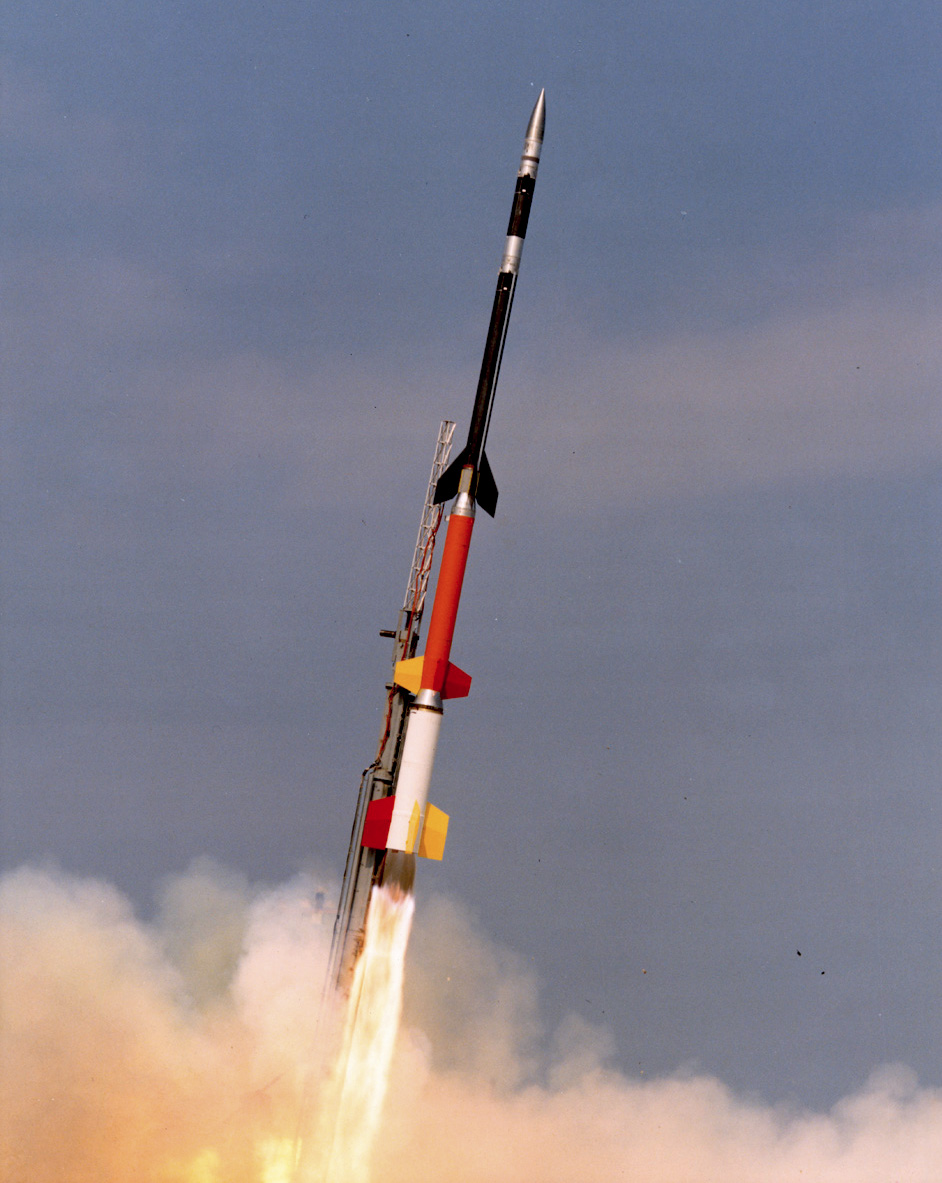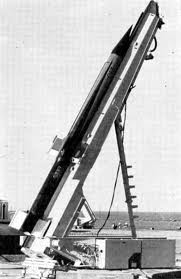|
Dauphin (rocket)
The Dauphin is a French sounding rocket, of which six versions were constructed between 1967 and 1978. It represents a modification of the starting stage of the Dragon with a larger payload nosecone. The Dauphin has a diameter of 56 centimetres, a launch weight of 1.132 metric tons, a length of 6.21 metres, a takeoff thrust of 90 kN and a ceiling of 150 kilometres. It belonged to a family of solid-propellant rockets including the Belier, the Centaure, and the Dragon, along with the Eridan. Launching experiments On September 14, 1972, a Dauphin rocket probed from the Guiana Base of Kourou. In November 1972, the third launching experiment, a very new and original experiment, took place on a Dauphin Rocket from French Guiana French Guiana ( or ; french: link=no, Guyane ; gcr, label=French Guianese Creole, Lagwiyann ) is an overseas departments and regions of France, overseas department/region and single territorial collectivity of France on the northern Atlantic .... R ... [...More Info...] [...Related Items...] OR: [Wikipedia] [Google] [Baidu] |
Sounding Rocket
A sounding rocket or rocketsonde, sometimes called a research rocket or a suborbital rocket, is an instrument-carrying rocket designed to take measurements and perform scientific experiments during its sub-orbital flight. The rockets are used to launch instruments from 48 to 145 km (30 to 90 miles) above the surface of the Earth, the altitude generally between weather balloons and satellites; the maximum altitude for balloons is about 40 km (25 miles) and the minimum for satellites is approximately 121 km (75 miles). Certain sounding rockets have an apogee between 1,000 and 1,500 km (620 and 930 miles), such as the Black Brant X and XII, which is the maximum apogee of their class. Sounding rockets often use military surplus rocket motors. NASA routinely flies the Terrier Mk 70 boosted Improved Orion, lifting 270–450-kg (600–1,000-pound) payloads into the exoatmospheric region between 97 and 201 km (60 and 125 miles). Etymology The origin of the term ... [...More Info...] [...Related Items...] OR: [Wikipedia] [Google] [Baidu] |
Dragon (rocket)
The Dragon is a two-stage French solid propellant sounding rocket used for high altitude research. The dragon's first stage was a Stromboli engine (diameter 56 cm) which burned 675 kg of fuel in 16 seconds and so produced a maximum thrust of 88 kN. A Bélier engine was used as the upper stage. It belonged thereby to a family of solid-propellant rockets derived from the Bélier, including the Centaure, the Dauphin and the Éridan. A payload of 30 to 120 kg could be carried on parabolic with apogees between 440 km (270 mi) (Dragon 2B) and 560 km (340 mi)(Dragon III) The Dragon was built in several versions including the Dragon-2B, and Dragon-3, Dragons have been launched from Andøya, Norway; Biscarrosse, France; Dumont d'Urville, Antarctica; Chamical, Argentina; CIEES in Hammaguir, Algeria ) , image_map = Algeria (centered orthographic projection).svg , map_caption = , image_map2 = , c ... [...More Info...] [...Related Items...] OR: [Wikipedia] [Google] [Baidu] |
Metric Ton
The tonne ( or ; symbol: t) is a unit of mass equal to 1000 kilograms. It is a non-SI unit accepted for use with SI. It is also referred to as a metric ton to distinguish it from the non-metric units of the short ton (United States customary units), and the long ton ( British imperial units). It is equivalent to approximately 2204.6 pounds, 1.102 short tons, and 0.984 long tons. The official SI unit is the megagram (symbol: Mg), a less common way to express the same mass. Symbol and abbreviations The BIPM symbol for the tonne is t, adopted at the same time as the unit in 1879.Table 6 . BIPM. Retrieved on 2011-07-10. Its use is also official for the metric ton in the United States, having been adopted by the United States |
Newton (unit)
The newton (symbol: N) is the unit of force in the International System of Units (SI). It is defined as 1 kg⋅m/s, the force which gives a mass of 1 kilogram an acceleration of 1 metre per second per second. It is named after Isaac Newton in recognition of his work on classical mechanics, specifically Newton's second law of motion. Definition A newton is defined as 1 kg⋅m/s (it is a derived unit which is defined in terms of the SI base units). One newton is therefore the force needed to accelerate one kilogram of mass at the rate of one metre per second squared in the direction of the applied force. The units "metre per second squared" can be understood as measuring a rate of change in velocity per unit of time, i.e. an increase in velocity by 1 metre per second every second. In 1946, Conférence Générale des Poids et Mesures (CGPM) Resolution 2 standardized the unit of force in the MKS system of units to be the amount needed to accelerate 1 kilogram of mass at the rate ... [...More Info...] [...Related Items...] OR: [Wikipedia] [Google] [Baidu] |
Solid Fuel
Solid fuel refers to various forms of solid material that can be burnt to release energy, providing heat and light through the process of combustion. Solid fuels can be contrasted with liquid fuels and gaseous fuels. Common examples of solid fuels include wood, charcoal, peat, coal, hexamine fuel tablets, dry dung, wood pellets, corn, wheat, rye, and other grains. Solid fuels are extensively used in rocketry as solid propellants. Solid fuels have been used throughout human history to create fire and solid fuel is still in widespread use throughout the world in the present day. Types of solid fuels Wood Wood fuel can refer to several fuels such as firewood, charcoal, ''wood chips'' sheets, pellets, and sawdust. The particular form used depends upon factors such as source, quantity, quality and application. In many areas, wood is the most easily available form of fuel, requiring no tools in the case of picking up dead wood, or few tools. Today, burning of wood is the largest use ... [...More Info...] [...Related Items...] OR: [Wikipedia] [Google] [Baidu] |
Centaure (rocket)
Centaure was a two-stage French sounding rocket consisting of a Belier (rocket) starting stage and a Venus upper stage. It was operated by CNES between 1961 and 1986. The Centaure has been built in a number of 230 and has been launched from the CIEES/Hammaguir missile range, Reggane, CELPA, Salto di Quirra, Esrange, Thumba, Sonmiani, and Andøya Andøya is the northernmost island in the Vesterålen archipelago, situated about inside the Arctic circle. Andøya is located in Andøy Municipality in Nordland county, Norway. The main population centres on the island include the villages of .... It had a maximum payload of 60 kg, a maximum height of 140 km, a launch thrust of 44 kN, a launch weight of 457 kg, a diameter of 0.28 m and a length of 6.02 m. It belongs to a family of solid-propellant rockets consisting of the Belier, Centaure, Dragon, Dauphin, and Eridan rockets. External links *https://web.archive.org/web/20131019123755/http://www.astronautix.com/lvs/centau ... [...More Info...] [...Related Items...] OR: [Wikipedia] [Google] [Baidu] |
Éridan (rocket)
The Éridan is a two-stage French sounding rocket, which resulted from the use of the Stromboli engine of the Dragon and/or Dauphin as first and second stage. It belonged thereby to a family of solid-propellant rockets from the Belier (rocket), the Centaure (rocket) Centaure was a two-stage French sounding rocket consisting of a Belier (rocket) starting stage and a Venus upper stage. It was operated by CNES between 1961 and 1986. The Centaure has been built in a number of 230 and has been launched from th ..., to the Dragon, the Dauphin and the Eridan. As the most powerful version of this series it could lift payloads from 100 to 420 kg to heights of 200 to a maximum of 460 km. Its climbing time is between 230 and 350 seconds.Les débuts de la recherche spatiale française 2846082154 IFHE,, Institut français d'histoire de l'espace - 2007 Intéressés, ils demandèrent au CNES d'envisager sérieusement un projet d'astronomie spatiale d'envergure qui serait réali ... [...More Info...] [...Related Items...] OR: [Wikipedia] [Google] [Baidu] |
Guiana Base Of Kourou
The Guianas, sometimes called by the Spanish loan-word ''Guayanas'' (''Las Guayanas''), is a region in north-eastern South America which includes the following three territories: * French Guiana, an overseas department and region of France * Guyana, formerly known as British Guiana from 1831 until 1966, after the colonies of Berbice, Essequibo, and Demerara, taken from the Netherlands in 1814, were merged into a single colony * Suriname, formerly Dutch Guiana, until 1814 together with Berbice, Essequibo and Demerara In the wider context, the Guianas also includes the following two territories: * Guayana Region in eastern Venezuela ( Amazonas, Bolívar, and Delta Amacuro states), formerly the Guayana Province, alternatively known as Spanish Guayana * State of Amapá in northern Brazil, known as Portuguese Guiana (or Brazilian Guiana) History Pre-colonial period Before the arrival of European colonials, the Guianas were populated by scattered bands of native Arawak peopl ... [...More Info...] [...Related Items...] OR: [Wikipedia] [Google] [Baidu] |
French Guiana
French Guiana ( or ; french: link=no, Guyane ; gcr, label=French Guianese Creole, Lagwiyann ) is an overseas departments and regions of France, overseas department/region and single territorial collectivity of France on the northern Atlantic Ocean, Atlantic coast of South America in the Guianas. It borders Brazil to the east and south and Suriname to the west. With a land area of , French Guiana is the second-largest Regions of France, region of France (more than one-seventh the size of Metropolitan France) and the largest Special member state territories and the European Union, outermost region within the European Union. It has a very low population density, with only . (Its population is less than that of Metropolitan France.) Half of its 294,436 inhabitants in 2022 lived in the metropolitan area of Cayenne, its Prefectures in France, capital. 98.9% of the land territory of French Guiana is covered by forests, a large part of which is Old-growth forest, primeval Tropical r ... [...More Info...] [...Related Items...] OR: [Wikipedia] [Google] [Baidu] |


